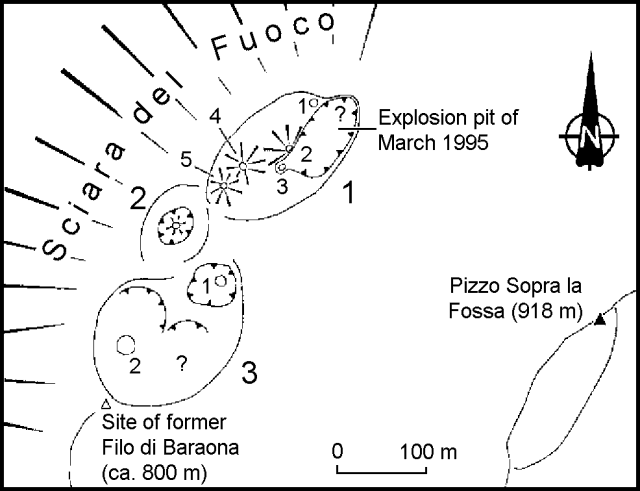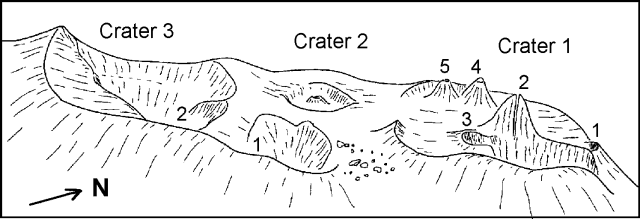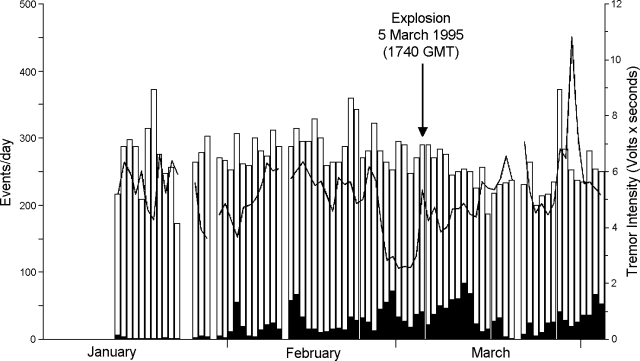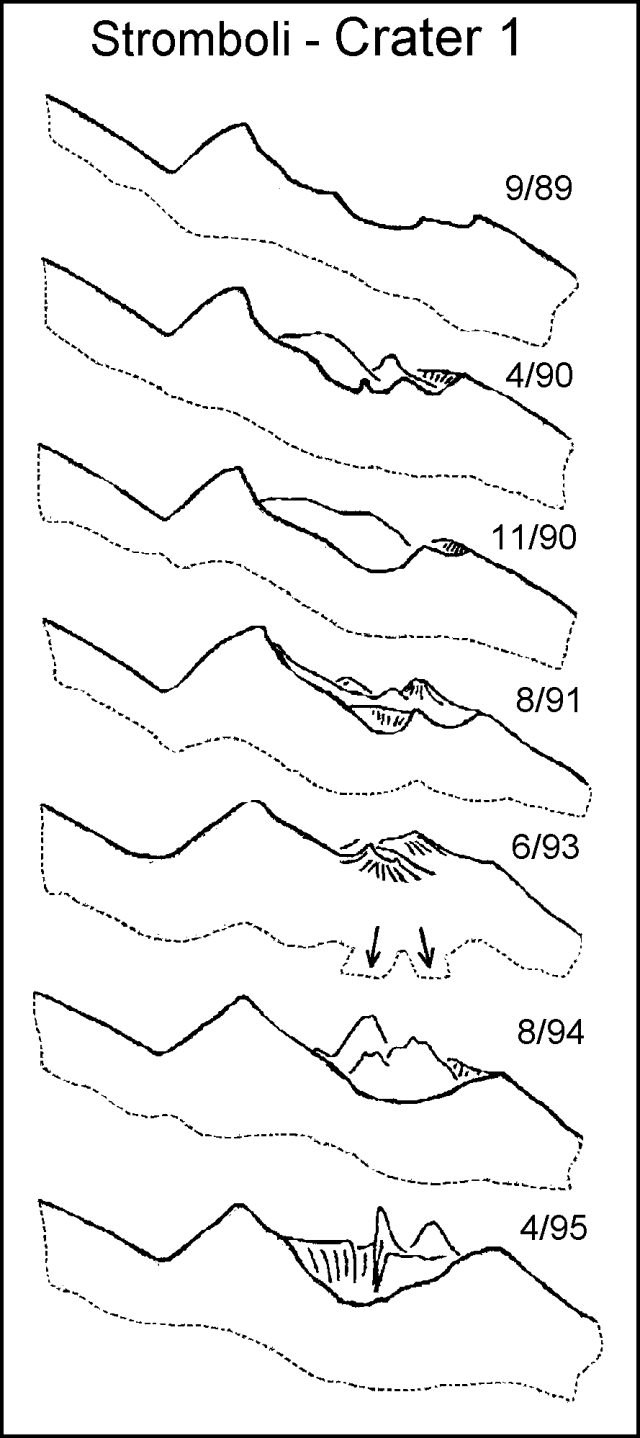Report on Stromboli (Italy) — April 1995
Bulletin of the Global Volcanism Network, vol. 20, no. 4 (April 1995)
Managing Editor: Richard Wunderman.
Stromboli (Italy) Explosion on 5 March and tremor; crater observations
Please cite this report as:
Global Volcanism Program, 1995. Report on Stromboli (Italy) (Wunderman, R., ed.). Bulletin of the Global Volcanism Network, 20:4. Smithsonian Institution. https://doi.org/10.5479/si.GVP.BGVN199504-211040
Stromboli
Italy
38.789°N, 15.213°E; summit elev. 924 m
All times are local (unless otherwise noted)
Due to funding problems, the power supply to the 3-component summit seismic station maintained by the University of Udine was interrupted from 10 December 1994 until 13 January 1995. The previous report (BGVN 20:01) described seismic activity through 9 December. This station has been operating since 1989, but may be permanently shut down in June if funding is not continued.
Stromboli island was visited by Giada Giuntoli and Boris Behncke on 19-24 April. Generally, the volcano showed much less activity than during a previous visit in August 1994, but an increase was evident on 23 April, resulting in the resumption of eruptions from Crater 1, which had been inactive for several weeks. Behncke also provided a review of crater morphology changes since 1989.
Seismicity, early 1995. Throughout 13 January-4 April the daily number of shocks remained roughly constant at 200-400 (figure 39). On 26 February tremor intensity began to decrease, and for a few days its average value remained stable below 3 Volts x seconds (Vs). However, the number of major shocks remained high. On 5 March a large explosion accompanied the return of tremor intensity to more usual values of around 5 Vs. The explosion threw pyroclastic material towards Forgia Vecchia and Fossetta, a depression SW of the crater area. The ejecta rose high enough to be clearly seen from the village of Stromboli, where the explosion was strongly felt. Tremor level continued to increase following the explosion; after a short decrease it quickly increased again to a peak of 10.8 Vs on 30 March. The number of major shocks decreased after 13 March. The increase in tremor intensity after the 5 March event did not match the behavior recorded after the explosions of 10 February 1993 and 16 October 1993 (BGVN 18:01, 18:02, and 18:09). On those occasions a remarkable decrease of all seismicity, and of the tremor level in particular, was noted immediately afterwards.
Activity on 20 April 1995. During a summit visit on 20 April between 0000 and 1500, activity was low compared to previous visits (September 1989, March and November 1990, August 1991, and March and August 1994); only three vents were erupting, in contrast to 10 in August. A detailed record of the eruptions was made for ~4 hours (table 2). The most notable change was the almost complete inactivity of Crater 1 (figures 40 and 41), which had contained at least six erupting vents in August 1994. Only vent 1/3 displayed some brief weak explosions, mostly of burning gas carrying a few incandescent fragments from the conduit walls. Crater 2 was not erupting, as in March and August 1994, but was the site of loud gas emissions.
Table 2. Eruptive activity at Stromboli observed between 0800 and 1210 on 20 April 1995, from Pizzo sopra la Fossa. Courtesy of Boris Behncke.
| Time | Crater-Vent | Description |
| 0800 | 1-3 | Brief (1 sec) gas explosion. |
| 0810 | 1-3 | Explosion (2 sec) with dark fumes. |
| 0811 | 3-2 | Very small explosion, no bombs visible. |
| 0811 | 3-1 | Strong bomb ejection to ~30 m. |
| 0813 | 3-2 | Lava fountain (15 sec) with some ash, to ~60 m above crater terrace. |
| 0816 | 1-3 | Brief thud with gas puff. |
| 0825 | 3-2 | Small, low fountain inside crater (5 sec). |
| 0830 | 2-? | Loud gas emission, no solid ejections (2-3 sec). |
| 0845 | 3-2 | Small ash explosion (10 sec) to 30 m. |
| 0857 | 3-2 | Small ash explosion (5 sec). |
| 0859 | 3-2 | Large bomb and ash fountain to 80 m (10 sec). |
| 0902 | 3-2 | Small bomb fountain with no ash to 30 m (5 sec). |
| 0906 | 3-2 | Very small explosion (mainly gas) inside crater (4 sec). |
| 0908 | 3-2 | Large bomb and ash fountain to 50 m, ash plume to 250 m (10 sec). |
| 0912 | 1-3 | Small gas explosion (2 sec). |
| 0937 | 3-1 | Single burst of large bombs to 30 m. |
| 0944 | 3-1 | Bomb ejection to ~20 m. |
| 0952 | 1-3 | Brief (1 sec) gas burst. |
| 0954 | 3-1 | Large bomb ejection with very large (up to 5 m) clots to ~30 m. |
| 1010 | 3-2 | Ash fountain to 150 m. |
| 1043 | 3-2 | Vigorous bomb and ash fountain; bombs to 80 m; dense ash column to >200 m (~30 sec). |
| 1045 | 1-3 | Small gas explosion (1 sec). |
| 1110 | 3-2 | Large bomb and ash fountain similar to that of 1043. |
| 1124 | 1-3 | Small gas explosion (1 sec). |
| 1132 | 1-3 | Small gas explosion (1 sec). |
| 1136 | 3-2 | Bomb and ash fountain, ash to >200 m. |
| 1148 | 3-1 | Abundant very large bombs to ~25 m; "whooshing" sound. |
| 1152 | 3-1 | Similar to 1148 but with less bombs. |
| 1155 | 3-1 | Similar to 1148 but with less bombs. |
| 1207 | 1-3 | Small gas explosion (1 sec). |
| 1208 | 3-2 | Bomb fountain to |
The most active vents were in Crater 3. Vent 3/1 activity consisted of almost continuous low spattering from a small lava pond with occasional bursts to ~60 m above the vent; similar activity was seen in March 1994 (BGVN 19:03). Rare bursts of large incandescent lava clots (up to 5 m in diameter) were accompanied by faint "whooshing" noises. Only twice were bombs ejected beyond the pit of 3/1, onto the NE wall of Crater 3. Eruptions from vent 3/2 occurred at intervals ranging from 2 minutes to >1 hour (see table 1), with periods of more frequent eruptions alternating with periods of very low activity. For example, six eruptions occurred during a 25-minute period (0845-0910), while from 0910 until 1210 there were only five more. Some of these eruptions consisted of loud gas emissions with very low spatter fountains, but most produced incandescent fountains 80-100 m high. Between sunrise on 20 April (at about 0700) and noon, the eruptions produced ash plumes up to 250 m high. Most of the ejected material fell back into the pit, but sometimes the entire NW rim of Crater 3 was covered with pyroclastics, and bombs rolled down the Sciara del Fuoco.
Activity on 21 and 23 April 1995. When observed from Punta Labronzo, on the N side of the island, on the evening of 21 April activity consisted of frequent low lava fountains from vent 3/2 and fluctuating incandescence over vent 3/1. Small ash plumes produced by eruptions from 3/2 were driven down the Sciara del Fuoco by strong winds. A dramatic change was evident late on 23 April, when the volcano was again observed from Punta Labronzo. Crater glow was much more intense, though still intermittent, and a persistent glow was visible at a small spot in the gap on the NE rim of Crater 1 (formed by the 5 March explosion). Vent 3/2 erupted as during the preceding days with somewhat larger ash plumes. However, a vent in the N part of Crater 1 ended the period of unusual inactivity of this crater, erupting spectacularly at intervals of 10-25 minutes. These eruptions were very brief (< 5 seconds) and produced cannon-shot-like bangs. Narrow incandescent columns rose obliquely to at least 150 m above the vent before falling onto the Sciara del Fuoco, depositing abundant incandescent material on the steep slope. For 3-5 minutes, incandescent material would cascade down to about half of the Sciara's extension, with a few large blocks tumbling farther. None appeared to reach the sea during the 1-hour observation period.
 |
Figure 40. Sketch map of the summit area of Stromboli, April 1995, showing the three craters and locations of vents. Courtesy of Boris Behncke. |
Morphologic changes occur almost continuously, with alternating constructive and destructive processes. Periods of spatter-cone growth and crater filling usually last from a few months to several years and are followed by either crater-floor subsidence or explosive disruption of the cones. Cone growth was continuous from at least 1989 (maybe 1986) until October 1993, interrupted only by small-scale cone collapse and minor explosions. At the same time, the craters were filled to their rims with tephra and minor lava flows (as in May 1993; BGVN 18:04). Two large explosions in October 1993 blew out all of the material from the craters, leaving deep (>60 m) and wide chasms with near-vertical walls, still present in March 1994 (BGVN 19:03). New spatter cones grew rapidly during unusually vigorous activity in the summer and autumn of 1994, reaching much larger dimensions than the 1989-93 cones. In March 1995, parts of these cones were again removed by powerful explosions similar to, but smaller than, the October 1993 explosions. Also during early 1995, subsidence in Crater 3 created two pits at least 50 m deep.
Crater 1 has been the site of the most pronounced spatter-cone growth during 1989-95. Very small cones rarely formed at vent 3/1 and within the one vent of Crater 2. Most of the filling of craters 2 and 3 was due to the accumulation of pyroclastics. Three large, steep-sided cones and several smaller ones grew within Crater 1 between March and August 1994, the largest at vent 1/2 in the central portion of the crater, reaching ~30 m above its base. A powerful explosion in March 1995 blew out a pit 60-70 m in diameter and some 40 m deep with vertical walls, removing half of the cone (figure 41), and exposing the now-inactive conduit. Some of the smaller 1994 cones were also destroyed during the March explosion. The "twin cones" above vents 1/4 and 1/5 had grown much larger since August 1994, reaching ~25 m above their bases. Crater 2 had changed little since the summer of 1994. The small (~5 m high) hornito in its center, first observed in October 1994 (BGVN 19:10) was still present.
 |
Figure 41. View of the crater terrace from Pizzo Sopra la Fossa, 20 April 1995. Courtesy of Boris Behncke. |
Crater 3, which had been filled with pyroclastics in August 1994, had two major depressions at the sites of vents 3/1 and 3/2. These depressions differ from the explosion pit in Crater 1, lacking its vertical walls and sharp rim, and may have formed in response to the lowering of the magmatic column sometime during November 1994 when the period of high-level activity ended. Another major change since 1989 is the significant upward growth of the entire crater terrace, most notable on the NW side facing the Sciara del Fuoco. This change is also evident on the profile views of Crater 1 taken from an observation point ~400 m NW (figure 42). Since the early and mid-20th century, the crater terrace has grown upwards by 50-100 m, completely burying the formerly conspicuous Filo di Baraona (figure 40), a frequently cited reference point in older literature at the SW end of the crater terrace. The highest point of the crater terrace is the SW rim of Crater 3, lying at ~780-800 m elevation (some 40 m above its NE rim), at the site of the former Filo di Baraona. This is significantly higher than the ~725 m estimated by Hornig-Kjarsgaard and others (1993).
Reference. Hornig-Kjarsgaard, I., Keller, J., Koberski, K., Stadlbauer, E., Francalanci, L., and Lenhart, R., 1993, Geology, stratigraphy and volcanological evolution of the island of Stromboli, Aeolian arc, Italy: Acta Vulcanologica, v. 3, p. 21-68.
Geological Summary. Spectacular incandescent nighttime explosions at Stromboli have long attracted visitors to the "Lighthouse of the Mediterranean" in the NE Aeolian Islands. This volcano has lent its name to the frequent mild explosive activity that has characterized its eruptions throughout much of historical time. The small island is the emergent summit of a volcano that grew in two main eruptive cycles, the last of which formed the western portion of the island. The Neostromboli eruptive period took place between about 13,000 and 5,000 years ago. The active summit vents are located at the head of the Sciara del Fuoco, a prominent scarp that formed about 5,000 years ago due to a series of slope failures which extends to below sea level. The modern volcano has been constructed within this scarp, which funnels pyroclastic ejecta and lava flows to the NW. Essentially continuous mild Strombolian explosions, sometimes accompanied by lava flows, have been recorded for more than a millennium.
Information Contacts: Roberto Carniel, Dipartimento di Georisorse e Territorio, via Cotonificio 114, I-33100 Udine, Italy; Giada Giuntoli and Boris Behncke, GEOMAR Research Center, Dept. of Volcanology and Petrology, Christian-Albrechts-Universitat zu Kiel, Wischhofstr. 1-3, 24148 Kiel, Germany.



